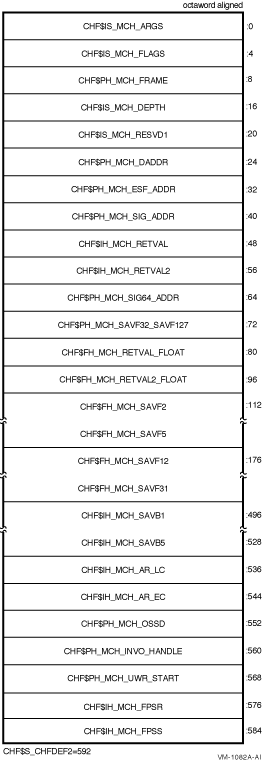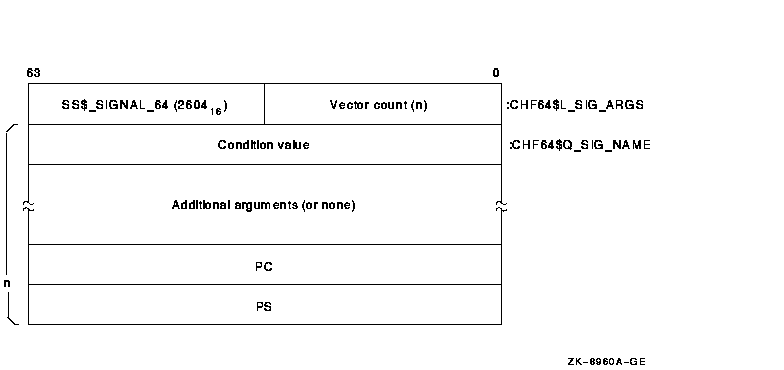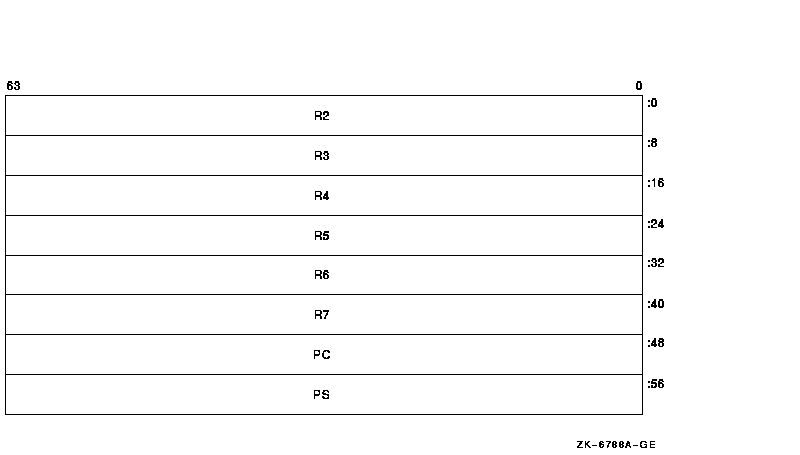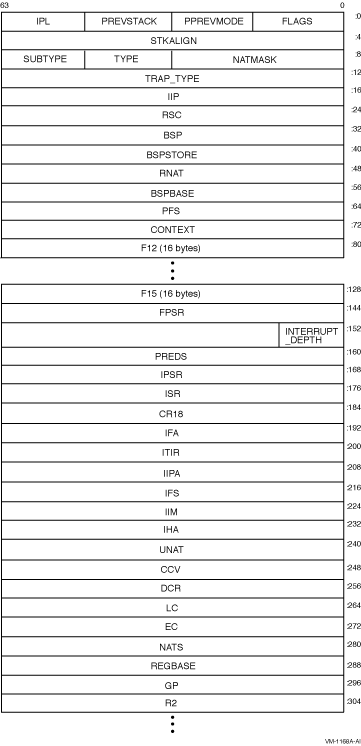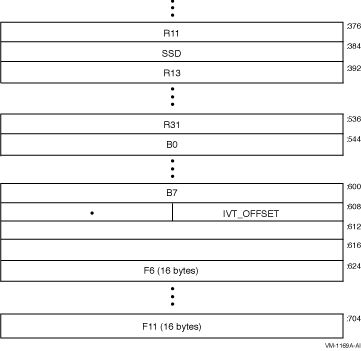OpenVMS (TM) Alpha system dump analyzer
...analyzing a selective memory dump...
Dump taken on 30-AUG-2000 13:13:46.83
SSRVEXCEPT, Unexpected system service exception
SDA> SHOW CRASH
Time of system crash: 30-AUG-1996 13:13:46.83
Version of system: OpenVMS (TM) Alpha Operating System, Version V7.3
System Version Major ID/Minor ID: 3/0
System type: DEC 3000 Model 400
Crash CPU ID/Primary CPU ID: 00/00
Bitmask of CPUs active/available: 00000001/00000001
CPU bugcheck codes:
CPU 00 -- SSRVEXCEPT, Unexpected system service exception
System State at Time of Exception
---------------------------------
Exception Frame:
----------------
R2 = 00000000.00000003
R3 = FFFFFFFF.80C63460 EXCEPTION_MON_NPRW+06A60
R4 = FFFFFFFF.80D12740 PCB
R5 = 00000000.000000C8
R6 = 00000000.00030038
R7 = 00000000.7FFA1FC0
PC = 00000000.00030078
PS = 00000000.00000003
00000000.00030068: STQ R27,(SP)
00000000.0003006C: BIS R31,SP,FP
00000000.00030070: STQ R26,#X0010(SP)
00000000.00030074: LDA R28,(R31)
PC => 00000000.00030078: LDL R28,(R28)
00000000.0003007C: BEQ R28,#X000007
00000000.00030080: LDQ R26,#XFFE8(R27)
00000000.00030084: BIS R31,R26,R0
00000000.00030088: BIS R31,FP,SP
PS =>
MBZ SPAL MBZ IPL VMM MBZ CURMOD INT PRVMOD
0 00 00000000000 00 0 0 KERN 0 USER
Signal Array
------------
Length = 00000005
Type = 0000000C
Arg = 00000000.00010000
Arg = 00000000.00000000
Arg = 00000000.00030078
Arg = 00000000.00000003
%SYSTEM-F-ACCVIO, access violation, reason mask=00, virtual address=0000000000000000,
PC=0000000000030078, PS=00000003
Saved Scratch Registers in Mechanism Array
------------------------------------------
R0 = 00000000.00020000 R1 = 00000000.00000000 R16 = 00000000.00020004
R17 = 00000000.00010050 R18 = FFFFFFFF.FFFFFFFF R19 = 00000000.00000000
R20 = 00000000.7FFA1F50 R21 = 00000000.00000000 R22 = 00000000.00010050
R23 = 00000000.00000000 R24 = 00000000.00010051 R25 = 00000000.00000000
R26 = FFFFFFFF.8010ACA4 R27 = 00000000.00010050 R28 = 00000000.00000000
CPU 00 Processor crash information
----------------------------------
CPU 00 reason for Bugcheck: SSRVEXCEPT, Unexpected system service exception
Process currently executing on this CPU: SYSTEM
Current image file: $31$DKB0:[SYS0.][SYSMGR]X.EXE;1
Current IPL: 0 (decimal)
CPU database address: 80D0E000
CPUs Capabilities: PRIMARY,QUORUM,RUN
General registers:
R0 = 00000000.00000000 R1 = 00000000.7FFA1EB8 R2 = FFFFFFFF.80D0E6C0
R3 = FFFFFFFF.80C63460 R4 = FFFFFFFF.80D12740 R5 = 00000000.000000C8
R6 = 00000000.00030038 R7 = 00000000.7FFA1FC0 R8 = 00000000.7FFAC208
R9 = 00000000.7FFAC410 R10 = 00000000.7FFAD238 R11 = 00000000.7FFCE3E0
R12 = 00000000.00000000 R13 = FFFFFFFF.80C6EB60 R14 = 00000000.00000000
R15 = 00000000.009A79FD R16 = 00000000.000003C4 R17 = 00000000.7FFA1D40
R18 = FFFFFFFF.80C05C38 R19 = 00000000.00000000 R20 = 00000000.7FFA1F50
R21 = 00000000.00000000 R22 = 00000000.00000001 R23 = 00000000.7FFF03C8
R24 = 00000000.7FFF0040 AI = 00000000.00000003 RA = FFFFFFFF.82A21080
PV = FFFFFFFF.829CF010 R28 = FFFFFFFF.8004B6DC FP = 00000000.7FFA1CA0
PC = FFFFFFFF.82A210B4 PS = 18000000.00000000
Processor Internal Registers:
ASN = 00000000.0000002F ASTSR/ASTEN = 0000000F
IPL = 00000000 PCBB = 00000000.003FE080 PRBR = FFFFFFFF.80D0E000
PTBR = 00000000.00001136 SCBB = 00000000.000001DC SISR = 00000000.00000000
VPTB = FFFFFFFC.00000000 FPCR = 00000000.00000000 MCES = 00000000.00000000
CPU 00 Processor crash information
----------------------------------
KSP = 00000000.7FFA1C98
ESP = 00000000.7FFA6000
SSP = 00000000.7FFAC100
USP = 00000000.7AFFBAD0
No spinlocks currently owned by CPU 00
|
| Example 2-2 SHOW STACK |
|---|
SDA> SHOW STACK
Current Operating Stack (KERNEL):
00000000.7FFA1C78 18000000.00000000
00000000.7FFA1C80 00000000.7FFA1CA0
00000000.7FFA1C88 00000000.00000000
00000000.7FFA1C90 00000000.7FFA1D40
SP => 00000000.7FFA1C98 00000000.00000000
00000000.7FFA1CA0 FFFFFFFF.829CF010 EXE$EXCPTN
00000000.7FFA1CA8 FFFFFFFF.82A2059C EXCEPTION_MON_PRO+0259C
00000000.7FFA1CB0 00000000.00000000
00000000.7FFA1CB8 00000000.7FFA1CD0
00000000.7FFA1CC0 FFFFFFFF.829CEDA8 EXE$SET_PAGES_READ_ONLY+00948
00000000.7FFA1CC8 00000000.00000000
00000000.7FFA1CD0 FFFFFFFF.829CEDA8 EXE$SET_PAGES_READ_ONLY+00948
00000000.7FFA1CD8 00000000.00000000
00000000.7FFA1CE0 FFFFFFFF.82A1E930 EXE$CONTSIGNAL_C+001D0
00000000.7FFA1CE8 00000000.7FFA1F40
00000000.7FFA1CF0 FFFFFFFF.80C63780 EXE$ACVIOLAT
00000000.7FFA1CF8 00000000.7FFA1EB8
00000000.7FFA1D00 00000000.7FFA1D40
00000000.7FFA1D08 00000000.7FFA1F00
00000000.7FFA1D10 00000000.7FFA1F40
00000000.7FFA1D18 00000000.00000000
00000000.7FFA1D20 00000000.00000000
00000000.7FFA1D28 00000000.00020000 SYS$K_VERSION_04
00000000.7FFA1D30 00000005.00000250 BUG$_NETRCVPKT
00000000.7FFA1D38 829CE050.000008F8 BUG$_SEQ_NUM_OVF
CHF$IS_MCH_ARGS 00000000.7FFA1D40 00000000.0000002C
CHF$PH_MCH_FRAME 00000000.7FFA1D48 00000000.7AFFBAD0
CHF$IS_MCH_DEPTH 00000000.7FFA1D50 FFFFFFFF.FFFFFFFD
CHF$PH_MCH_DADDR 00000000.7FFA1D58 00000000.00000000
CHF$PH_MCH_ESF_ADDR 00000000.7FFA1D60 00000000.7FFA1F00
CHF$PH_MCH_SIG_ADDR 00000000.7FFA1D68 00000000.7FFA1EB8
CHF$IH_MCH_SAVR0 00000000.7FFA1D70 00000000.00020000 SYS$K_VERSION_04
CHF$IH_MCH_SAVR1 00000000.7FFA1D78 00000000.00000000
CHF$IH_MCH_SAVR16 00000000.7FFA1D80 00000000.00020004 UCB$M_LCL_VALID+00004
CHF$IH_MCH_SAVR17 00000000.7FFA1D88 00000000.00010050 SYS$K_VERSION_16+00010
CHF$IH_MCH_SAVR18 00000000.7FFA1D90 FFFFFFFF.FFFFFFFF
CHF$IH_MCH_SAVR19 00000000.7FFA1D98 00000000.00000000
CHF$IH_MCH_SAVR20 00000000.7FFA1DA0 00000000.7FFA1F50
CHF$IH_MCH_SAVR21 00000000.7FFA1DA8 00000000.00000000
CHF$IH_MCH_SAVR22 00000000.7FFA1DB0 00000000.00010050 SYS$K_VERSION_16+00010
CHF$IH_MCH_SAVR23 00000000.7FFA1DB8 00000000.00000000
CHF$IH_MCH_SAVR24 00000000.7FFA1DC0 00000000.00010051 SYS$K_VERSION_16+00011
CHF$IH_MCH_SAVR25 00000000.7FFA1DC8 00000000.00000000
CHF$IH_MCH_SAVR26 00000000.7FFA1DD0 FFFFFFFF.8010ACA4 AMAC$EMUL_CALL_NATIVE_C+000A4
CHF$IH_MCH_SAVR27 00000000.7FFA1DD8 00000000.00010050 SYS$K_VERSION_16+00010
CHF$IH_MCH_SAVR28 00000000.7FFA1DE0 00000000.00000000
00000000.7FFA1DE8 00000000.00000000
00000000.7FFA1DF0 00000000.00000000
00000000.7FFA1DF8 00000000.00000000
00000000.7FFA1E00 00000000.00000000
00000000.7FFA1E08 00000000.00000000
00000000.7FFA1E10 00000000.00000000
00000000.7FFA1E18 00000000.00000000
00000000.7FFA1E20 00000000.00000000
00000000.7FFA1E28 00000000.00000000
00000000.7FFA1E30 00000000.00000000
00000000.7FFA1E38 00000000.00000000
00000000.7FFA1E40 00000000.00000000
00000000.7FFA1E48 00000000.00000000
00000000.7FFA1E50 00000000.00000000
00000000.7FFA1E58 00000000.00000000
00000000.7FFA1E60 00000000.00000000
00000000.7FFA1E68 00000000.00000000
00000000.7FFA1E70 00000000.00000000
00000000.7FFA1E78 00000000.00000000
00000000.7FFA1E80 00000000.00000000
00000000.7FFA1E88 00000000.00000000
00000000.7FFA1E90 00000000.00000000
00000000.7FFA1E98 00000000.00000000
CHF$PH_MCH_SIG64_ADDR 00000000.7FFA1EA0 00000000.7FFA1ED0
00000000.7FFA1EA8 00000000.00000000
00000000.7FFA1EB0 00000000.7FFA1F50
00000000.7FFA1EB8 0000000C.00000005
00000000.7FFA1EC0 00000000.00010000 SYS$K_VERSION_07
00000000.7FFA1EC8 00000003.00030078 SYS$K_VERSION_01+00078
CHF$L_SIG_ARGS 00000000.7FFA1ED0 00002604.00000005 UCB$M_TEMPLATE+00604
CHF$L_SIG_ARG1 00000000.7FFA1ED8 00000000.0000000C
00000000.7FFA1EE0 00000000.00010000 SYS$K_VERSION_07
00000000.7FFA1EE8 00000000.00000000
00000000.7FFA1EF0 00000000.00030078 SYS$K_VERSION_01+00078
00000000.7FFA1EF8 00000000.00000003
INTSTK$Q_R2 00000000.7FFA1F00 00000000.00000003
INTSTK$Q_R3 00000000.7FFA1F08 FFFFFFFF.80C63460 EXCEPTION_MON_NPRW+06A60
INTSTK$Q_R4 00000000.7FFA1F10 FFFFFFFF.80D12740 PCB
INTSTK$Q_R5 00000000.7FFA1F18 00000000.000000C8
INTSTK$Q_R6 00000000.7FFA1F20 00000000.00030038 SYS$K_VERSION_01+00038
INTSTK$Q_R7 00000000.7FFA1F28 00000000.7FFA1FC0
INTSTK$Q_PC 00000000.7FFA1F30 00000000.00030078 SYS$K_VERSION_01+00078
INTSTK$Q_PS 00000000.7FFA1F38 00000000.00000003
Prev SP (7FFA1F40) ==> 00000000.7FFA1F40 00000000.00010050 SYS$K_VERSION_16+00010
00000000.7FFA1F48 00000000.00010000 SYS$K_VERSION_07
00000000.7FFA1F50 FFFFFFFF.8010ACA4 AMAC$EMUL_CALL_NATIVE_C+000A4
00000000.7FFA1F58 00000000.7FFA1F70
00000000.7FFA1F60 00000000.00000001
00000000.7FFA1F68 FFFFFFFF.800EE81C RM_STD$DIRCACHE_BLKAST_C+005AC
00000000.7FFA1F70 FFFFFFFF.80C6EBA0 SCH$CHSEP+001E0
00000000.7FFA1F78 00000000.829CEDE8 EXE$SIGTORET
00000000.7FFA1F80 00010050.00000002 SYS$K_VERSION_16+00010
00000000.7FFA1F88 00000000.00020000 SYS$K_VERSION_04
00000000.7FFA1F90 00000000.00030000 SYS$K_VERSION_01
00000000.7FFA1F98 FFFFFFFF.800A4D64 EXCEPTION_MON_NPRO+00D64
00000000.7FFA1FA0 00000000.00000003
00000000.7FFA1FA8 FFFFFFFF.80D12740 PCB
00000000.7FFA1FB0 00000000.00010000 SYS$K_VERSION_07
00000000.7FFA1FB8 00000000.7AFFBAD0
00000000.7FFA1FC0 00000000.7FFCF880 MMG$IMGHDRBUF+00080
00000000.7FFA1FC8 00000000.7B0E9851
00000000.7FFA1FD0 00000000.7FFCF818 MMG$IMGHDRBUF+00018
00000000.7FFA1FD8 00000000.7FFCF938 MMG$IMGHDRBUF+00138
00000000.7FFA1FE0 00000000.7FFAC9F0
00000000.7FFA1FE8 00000000.7FFAC9F0
00000000.7FFA1FF0 FFFFFFFF.80000140 SYS$PUBLIC_VECTORS_NPRO+00140
00000000.7FFA1FF8 00000000.0000001B
.
.
.
|
2.7.2.8 Illegal Page Faults
When an illegal page fault occurs, the stack appears as pictured in Figure 2-8.
Figure 2-8 Stack Following an Illegal Page-Fault Error
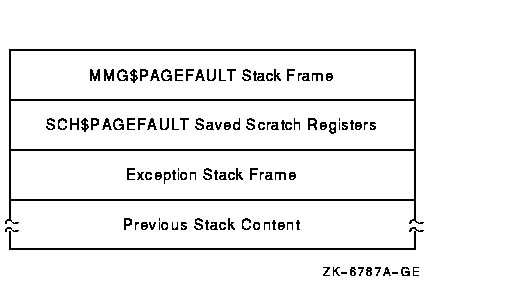
The stack contents are as follows:
| MMG$PAGEFAULT Stack Frame | Stack frame built at entry to MMG$PAGEFAULT, the page fault exception service routine. On Alpha, the frame includes the contents of the following registers at the time of the page fault: R3, R8, R11 to R15, R29 (frame pointer) |
| SCH$PAGEFAULT Saved Scratch Registers (Alpha only) | Contents of the following registers at the time of the page fault: R0, R1, R16 to R28 |
| Exception Stack Frame | Exception stack frame ---see Figure 2-5, Figure 2-6 and Figure 2-7 |
| Previous Stack Content | Contents of the stack prior to the illegal page-fault error |
When you analyze a dump caused by a PGFIPLHI bugcheck, the SHOW STACK
command identifies the exception stack frame using the symbols shown in
Table 2-11 or Table 2-12. The SHOW CRASH or CLUE CRASH command
displays the instruction that caused the page fault and the
instructions around it.
2.8 Page Protections and Access Rights
Page protections and access rights are different on Alpha and Integrity server systems. They are visible in output from the following commands:
SHOW PAGE
SHOW PROCESS/PAGE
EXAMINE/PTE
EVALUATE/PTE
Due to system differences, there is a need to distinguish "Write+Read+Execute" from "Write+Read" and to distinguish "Read+Execute" from "Read".
On an Alpha system, W=W+R+E and R=R+E but on an IA64 system, additional w and r indicators are introduced for non-execute cases.
On Alpha, page protection is described by 8 bits--- one Read bit for each mode, and one Write Bit. Therefore in the "Read" column, there might be KESU (read access in all modes) or K--- (read access in Kernel mode only) or NONE (no read access). Similarly in the "Writ" column. Not all combinations of the 8 bits are possible (for example, Write access for a mode implies Read access at that mode and both Read and Write access for all inner modes).
On Integrity servers, page protection is described by 5 bits, a combination of the Access Rights and Privilege Level fields. SDA interprets these with a single character to describe access in each mode, as shown in Table 2-13.
| Code | Meaning |
|---|---|
| r | Read |
| w | Read, Write |
| R | Read, Execute |
| W | Read, Write, Execute |
| X | Execute |
| K | Promote to Kernel |
| E | Promote to Executive |
| S | Promote to Supervisor |
| - | No access |
For example
WRRR
means Kernel mode has Read+Write+Execute access; all other modes have
Read+Execute access.
2.9 Inducing a System Failure
If the operating system is not performing well and you want to create a dump you can examine, you must induce a system failure. Occasionally, a device driver or other user-written, kernel-mode code can cause the system to execute a loop of code at a high priority, interfering with normal system operation. This loop can occur even though you have set a breakpoint in the code if the loop is encountered before the breakpoint. To gain control of the system in such circumstances, you must cause the system to fail and then reboot it.
If the system has suspended all noticeable activity and is hung, see the examples of causing system failures in Section 2.9.2.
If you are generating a system failure in response to a system hang, be
sure to record the PC and PS as well as the contents of the integer
registers at the time of the system halt.
2.9.1 Meeting Crash Dump Requirements
The following requirements must be met before the operating system can write a complete crash dump:
- You must not halt the system until the console dump messages have been printed in their entirety and the memory contents have been written to the crash dump file. Be sure to allow sufficient time for these events to take place or make sure that all disk activity has stopped before using the console to halt the system.
- There must be a crash dump file in SYS$SPECIFIC:[SYSEXE]: named
either SYSDUMP.DMP or PAGEFILE.SYS.
This dump file must be either large enough to hold the entire contents of memory (as discussed in Section 2.2.1.1) or, if the DUMPSTYLE system parameter is set, large enough to accommodate a subset or compressed dump (also discussed in Section 2.2.1.1).
If SYSDUMP.DMP is not present, the operating system attempts to write crash dumps to PAGEFILE.SYS. In this case, the SAVEDUMP system parameter must be 1 (the default is 0). - Alternatively, the system must be set up for DOSD. See Section 2.2.1.5, and the HP OpenVMS System Manager's Manual, Volume 2: Tuning, Monitoring, and Complex Systems for details.
- The DUMPBUG system parameter must be 1 (the default is 1).
2.9.2 Procedure for Causing a System Failure
This section tells you how to enter the XDelta utility (XDELTA) to force a system failure.
Before you can use XDelta, it must be loaded at system startup. To load XDelta during system bootstrap, you must set bit 1 in the boot flags. See the HP OpenVMS Version 8.4 Upgrade and Installation Manual for information about booting with the XDelta utility.
On Alpha, put the system in console mode by pressing Ctrl/P or the Halt push button. Enter the following commands at the console prompt to enter XDelta:
>>> DEPOSIT SIRR E >>> CONTINUE |
On Integrity servers, enter XDELTA by pressing Ctrl/P at the console.
Once you have entered XDelta, use any valid XDelta commands to examine register or memory locations, step through code, or force a system failure (by entering ;C under XDelta). See the HP OpenVMS Delta/XDelta Debugger Manual for more information about using XDelta.
On Alpha, if you did not load XDelta, you can force a system crash by entering console commands that make the system incur an exception at high IPL. At the console prompt, enter commands to set the program counter (PC) to an invalid address and the PS to kernel mode at IPL 31 before continuing. This results in a forced INVEXCEPTN-type bugcheck. Some HP Alpha computers employ the console command CRASH (which will force a system failure) while other systems require that you manually enter the commands.
Enter the following commands at the console prompt to force a system failure:
>>> DEPOSIT PC FFFFFFFFFFFFFF00 >>> DEPOSIT PS 1F00 >>> CONTINUE |
For more information, refer to the hardware manuals that accompanied your Alpha computer.
On Integrity servers, pressing Ctrl/P when XDelta is not loaded causes the OpenVMS system to output the following:
Crash (y/n): |
A response of Y forces a system crash; entering any other character lets the system continue processing.
| Previous | Next | Contents | Index |

